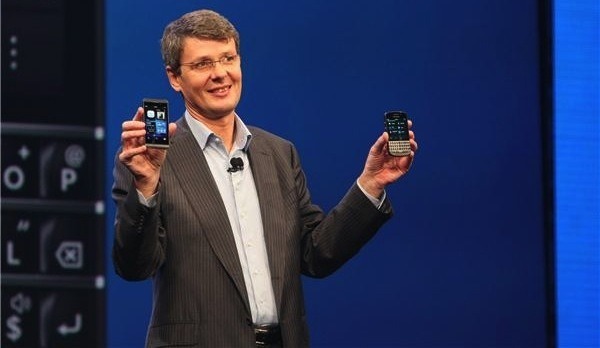BlackBerry CEO Heins: Focus on enterprise mobility over device sales

Does BlackBerry have any real staying power? That question hung over the smartphone maker after a sluggish first quarter that was supposed to benefit from new product launches. Analysts are likely to question BlackBerry's ability to recover.
Thorsten Heins, CEO of BlackBerry, tried to recast the company narrative around enterprise mobility management instead of devices.

And there was a good reason for that pitch from Heins. BlackBerry's first quarter missed on multiple metrics as the company's revenue and smartphone shipments failed to live up to expectations. What's most worrisome for BlackBerry is that analysts were expecting a solid quarter based on channel fill.
The company reported a first quarter loss of $84 million, or 16 cents a share, on revenue of $3.1 billion. Adjusted loss for the first quarter, which excludes charges, was 13 cents a share. Wall Street was looking for earnings of 6 cents a share on revenue of $3.36 billion.
Earlier: BlackBerry Q1: Recovery, turnaround not going so well
Meanwhile, BlackBerry shipped 6.8 million smartphones in the quarter. Wall Street was expecting about 7.3 million smartphone shipments. Of that first quarter sum, BlackBerry 10 shipments were about 2.7 million. BlackBerry also had 72 million subscribers, but won't disclose that tally going forward.
Here's the problem: If BlackBerry can't nail a quarter that was supposed to be powered by the Q10 and Z10, what will future quarters look like when the company lives and dies by sellthrough to users?
Heins's chore on the earnings conference call was clear yet challenging. All Heins had to do was get folks focused on the long run and emphasize that BlackBerry is about more than devices. Heins then plugged BlackBerry's enterprise roots and its BlackBerry Enterprise Server. The company will continue to roll out its BlackBerry 10 platform and BlackBerry Enterprise Server 10 is expected to gain some traction. However, it's unclear whether BlackBerry can be that "vibrant player" Heins needs the company to be.
Heins's argument boiled down to a few key quotes from the conference call:
We are five months into our platform transformation that we anticipate will drive future Smartphone devices, greater enterprise efficiency and new mobile computing opportunity for many years to come. We've never been a device-only company, as we are also running a global secure data network and services business, and we don't plan to run the company with a short-term, device-only strategy. What is exciting about BlackBerry today is that we're getting very comfortable with who we are as a company and where we will fit in the market.
Translation: Hey, don't get obsessed with Z10 and Q10 — especially if they don't sell all that well. It's early and most of our coin is made on the enterprise side anyway. We're going back to our roots.
The BlackBerry 10 smartphone portfolio is just starting to fill out. We're only five months in and it has achieved significant numbers of technical acceptances globally. The current and upcoming product in our portfolio will also allow us to address different market tiers. Our goal with our Smartphone portfolio is to have no more than six new devices in the market at any given time. This targeted approach to devices will allow us to efficiently establish and differentiate BlackBerry 10 based on features such as user interface, our iconic QWERTY keyboard and our secure enterprise productivity strength.
Translation: The portfolio is important, but Heins noted that the Z10 and Q10 are also about emerging markets, which are still buying BlackBerry 7 devices. The numbers back Heins up a bit. You can't necessarily judge BlackBerry entirely by the U.S. By region, BlackBerry's fate increasingly relies on Europe, Middle East and Africa. That region showed strong sales growth from a year ago. In the first quarter, EMEA revenue was $1.34 billion, up from $1.03 billion a year ago. Asia Pacific also showed a revenue gain. However, North American and Latin American sales fell from a year ago.
While the enterprise environment requires a longer sales cycle than consumer-only-focused devices, the successful adoption of BES 10 remains an important driver for future unit sales and service revenue opportunities. 60% of BlackBerry Fortune 500 customers have already ordered, downloaded or installed BES 10. And in another way, we look at the strong interest in BES 10 by a vertical market demonstrating the broad enterprise appeal of our platform. Based on third party sources ranking size of companies by industry, BES 10 has already been ordered, downloaded or installed by three of the top 10 companies and leaders in hospitality. 4 of the top 10 companies in retail, 5 of the top 10 financial institutions, 3 of the top 10 companies in construction, 4 of the top 10 companies in communication, and 6 of the top 10 companies in healthcare.
Translation: Wall Street needs to focus on BlackBerry's enterprise and bring-your-own-device management potential.
We are also targeting new services in consumer, starting with leveraging BlackBerry Messenger. Our approach to growing BBM cross-platform is an example of the service revenue opportunities we can capitalize upon with our technology and innovation.
Translation: BlackBerry can play prosumer services too.
What's unclear is whether or not BlackBerry can convince people that its enterprise strategy has legs. Perceptions about BlackBerry's enterprise mobility fate largely rests with IT deployment cycles, which take time.